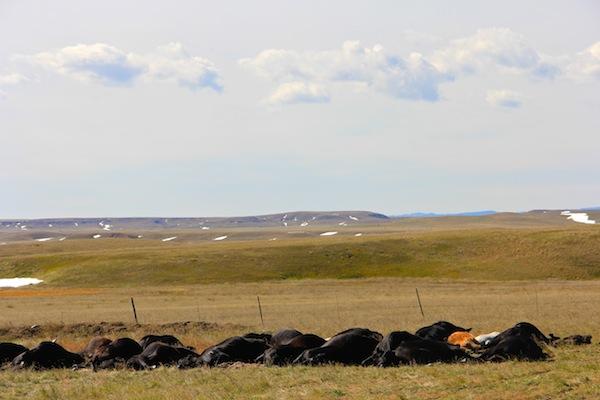When the federal government shut down last fall, it wasn’t just monuments and national parks that closed as a result. Funding streams for the Supplemental Nutrition Assistance Program (SNAP) were also reduced, and, in turn, Indian programs meant to feed hungry families were stretched thin.
“It was a canary in the coal mine for what we’re going to see next,” says Janie Simms Hipp, director of the Indigenous Food and Agriculture Initiative at the University of Arkansas School of Law, who predicts that the new cuts by Congress to SNAP will be difficult for many Native American families to bear.
On February 4, the Senate passed a farm bill by a vote of 68 – 32 that calls for $8 billion in cuts to the SNAP food-stamp program over the next decade; the Senate vote followed a 251-166 affirmative vote on the same bill in the House January 29. It’s a smaller cut than the $40 billion House Republicans passed last September, but still big enough to have Indian food and nutrition specialists worried about the net result.
RELATED: House Approves $40 Billion Cut to Food Stamps Over 10 Years
According to federal statistics, SNAP in 2008 served an average of 540,000 low-income people who identified as American Indian/Alaska Native alone and 260,000 who identified as American Indian/Alaska Native and White per month. The National Congress of American Indians (NCAI) says that 20 percent of American Indian/Alaska Native households receive food stamps.
Tod Roberson, president of the National Association of Food Distribution Programs on Indian Reservations (FDPIR), says that the reduced federal funding resulting from the October shutdown, combined with new federal rules affecting FDPIR that went into effect around the same time, led to an increase in participation at nearly every tribal FDPIR site. FDPIR is a federal program that provides U.S. Department of Agriculture (USDA) foods through tribes to low-income Indian country-based households; it served approximately 80,000 individuals per month in fiscal year 2011, according to administrative data. Over 275 tribes currently participate in FDPIR, but there are 566 federally recognized tribes, so many tribal citizens don’t have access.
“One tribe has already seen an additional 1,000 plus new participants,” Roberson says. “The monthly participation levels are being closely monitored in comparison to past trends.”
If the immediate past is prologue, Roberson says it is “extremely plausible that additional resources will be needed” for FDPIR as a result of the SNAP cuts, which are expected to soon be signed into law by President Barack Obama.
The hope of many tribal advocates is that the FDPIR program can pick up the slack for most Indian families, but whether there are enough resources for that to happen is unknown right now.
“We’re going to see a ripple,” says Hipp, who founded the USDA’s Office of Tribal Relations before joining the University of Arkansas in 2013. “If you take the lesson of the shutdown as an example of what could happen upon full implantation of cuts to SNAP, we (tribes and tribal citizens) really need to be prepared.”
On another worrisome note beyond food stamps, tribal leaders with the Cheyenne-Arapaho Tribes are lamenting that the farm bill includes language inserted by Rep. Frank Lewis (R-Oklahoma) that continue to keep traditional tribal homelands away from the tribe. The tribe unsuccessfully called on Congress to remove the language, which was first inserted in 2002, once more in 2008, and now again in 2014.
Alongside the negatives, there are a few new provisions in the farm bill that are cause for celebration in Indian country. One of these provisions requires
a feasibility study from the Secretary of Agriculture on the tribal administration of federal food assistance programs. “FDPIR is already managed by tribes [and] FDPIR has proven that tribes can effectively run these programs and in most if not all cases do so with greater attention to the needs on the ground of their people,” Hipp says of the provision. “I’m all in favor of turning over these programs to be run by tribes for the benefit and service to their people.”
The farm bill also creates a new demonstration project for the FDPIR to include traditional and locally grown foods by Native farmers, ranchers, and producers. “This shows that Congress is acknowledging that local, traditional foods continue to be important to our people,” says Hipp, a citizen of the Chickasaw Nation.
Both the feasibility study and the demonstration project still need to receive funding from congressional appropriators, but tribal advocates, including those at NCAI, say the authorizing language is a positive – and long fought for – first step.
For both provisions to be successful, Hipp says that the input of FDPIR tribal managers and other Indian food and agricultural experts will be important. “Such a study and demonstration project must be handled in a way and by entities that truly understand Indian country agriculture from farm to fork, and tribal governments must be involved as they have the authority to set policy within their jurisdictional borders that would form the ongoing cradle for local and traditional food production, “ she says. “The study should not be done by an entity without that intimate level of knowledge, or we won’t uncover all the issues that should be included in a comprehensive report on the topic.”
A third new provision of the farm bill related to Indian country allows for the use of traditional foods in public food services programs such as schools, elder care facilities, and hospitals and makes tribes explicitly eligible for Soil and Water Conservation Act Programs.
While the pro-Indian provisions in the final legislation are exciting to advocates like Hipp, the cuts are still tough to swallow. “I’m not excited about any cuts to hunger programs—we have a whole bunch of hungry people,” she says. “But at the end of the day I’m also a student of agriculture policy, and farm bills have always been an exercise in compromise.”
Read more at http://indiancountrytodaymedianetwork.com/2014/02/05/how-will-farm-bill-food-stamp-cuts-impact-indian-country-153422?page=0%2C1


 Seeking to nullify the Sixth Circuit’s ruling in National Cotton Council v. EPA and the resulting general permit, sections 12323 and 100013 amend CWA to exclude pesticides from the law’s standards and its permitting requirements. Known as the National Pollution Discharge Elimination System (NPDES), CWA requires all point sources, which are discernible and discreet conveyances, to obtain either individual or general permits. Whether a point source must obtain an individual or general permit depends on the size of the point source and type of activity producing the pollutants. Regardless of whether it is a general permit or individual permit, an entity cannot pollute without a permit and in most cases can only permit in the amounts (called effluent limitations) and ways prescribed in the permit.
Seeking to nullify the Sixth Circuit’s ruling in National Cotton Council v. EPA and the resulting general permit, sections 12323 and 100013 amend CWA to exclude pesticides from the law’s standards and its permitting requirements. Known as the National Pollution Discharge Elimination System (NPDES), CWA requires all point sources, which are discernible and discreet conveyances, to obtain either individual or general permits. Whether a point source must obtain an individual or general permit depends on the size of the point source and type of activity producing the pollutants. Regardless of whether it is a general permit or individual permit, an entity cannot pollute without a permit and in most cases can only permit in the amounts (called effluent limitations) and ways prescribed in the permit.
